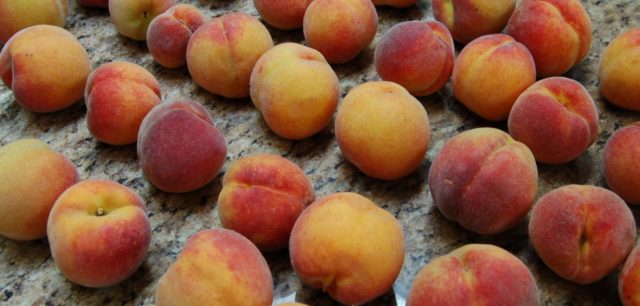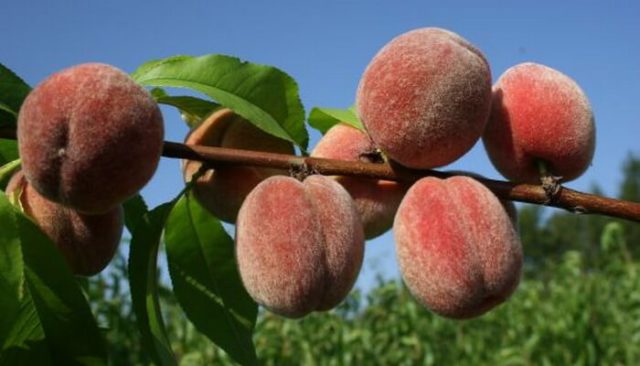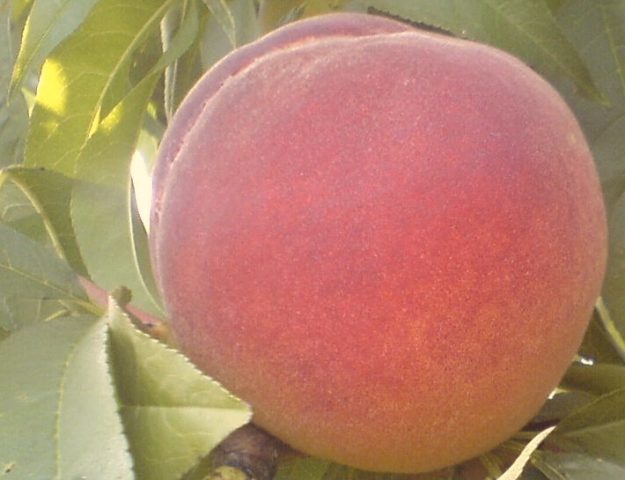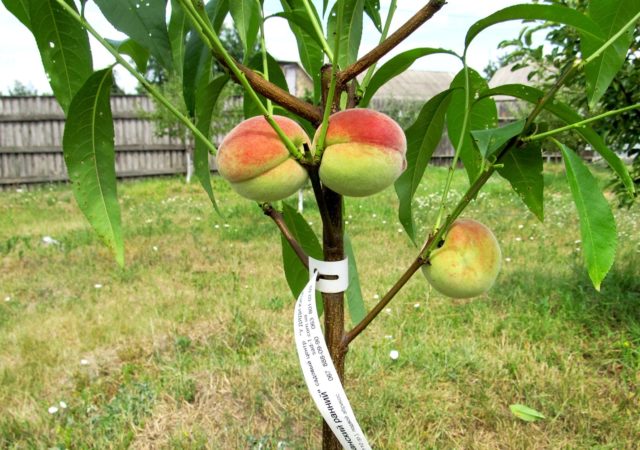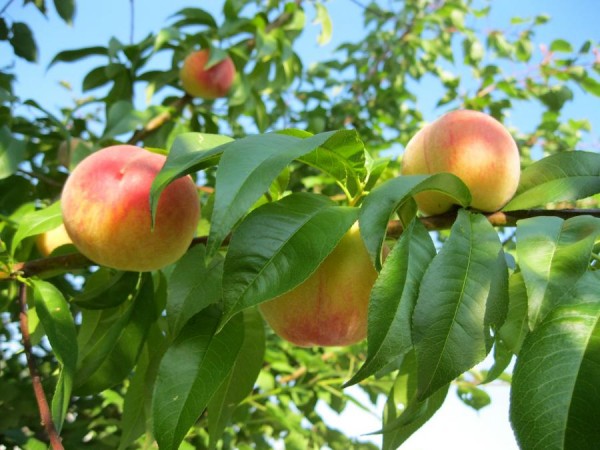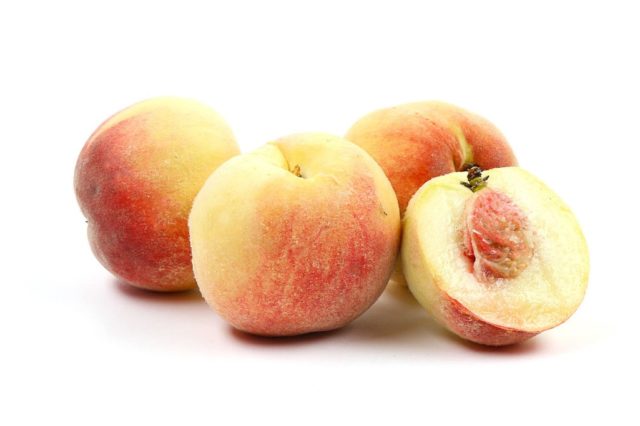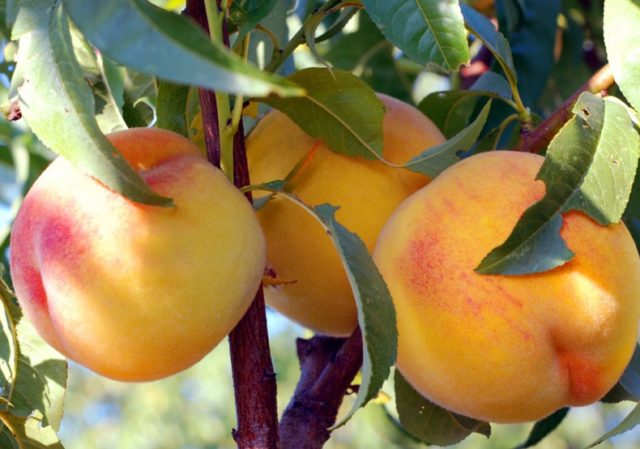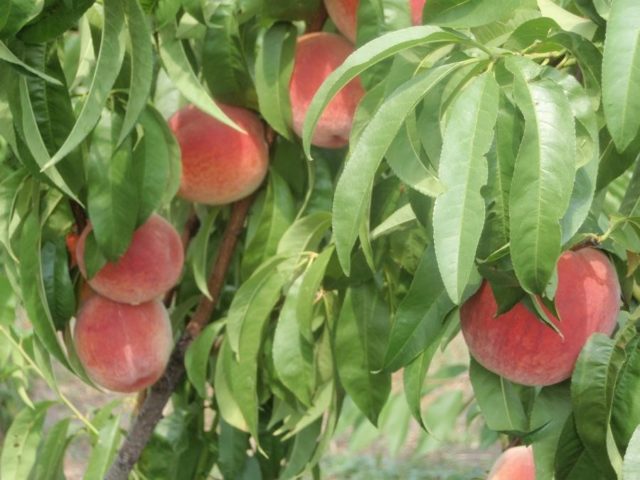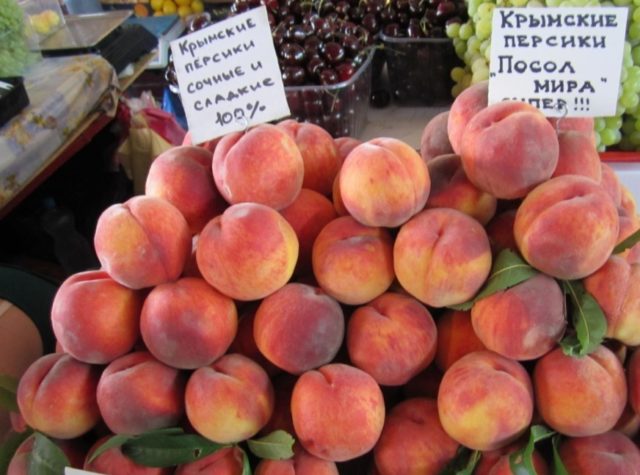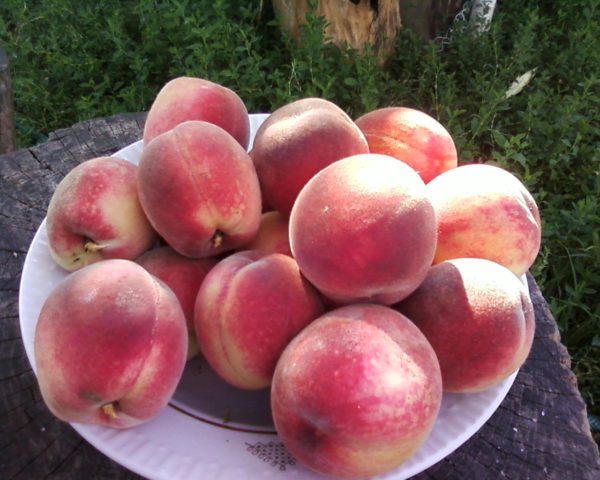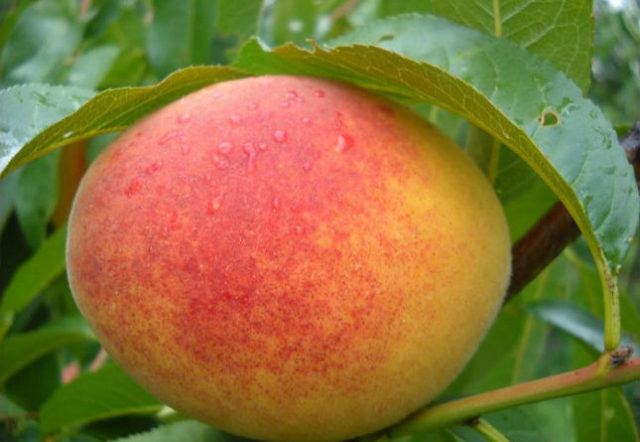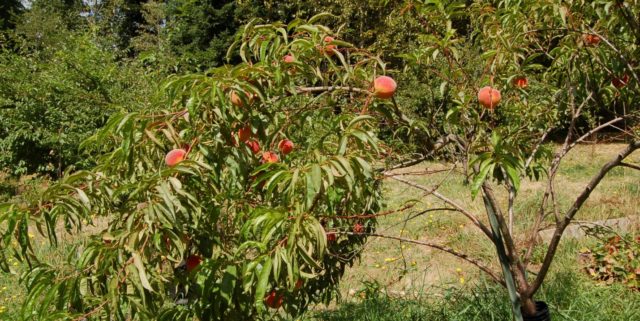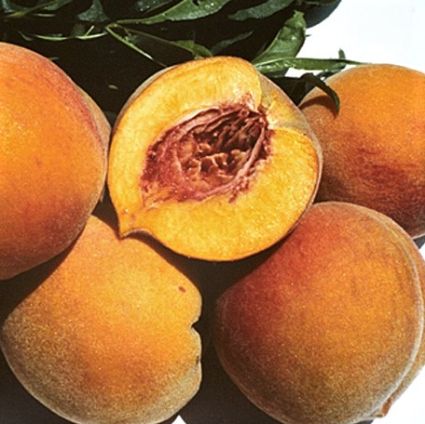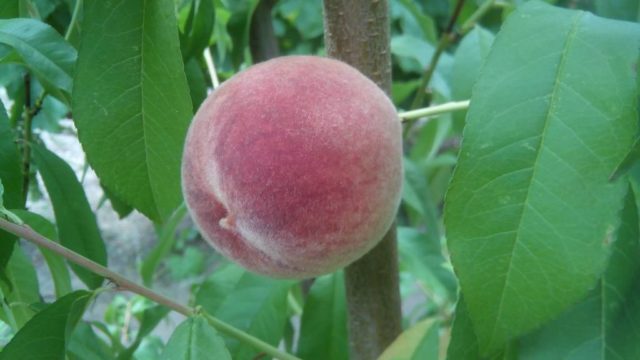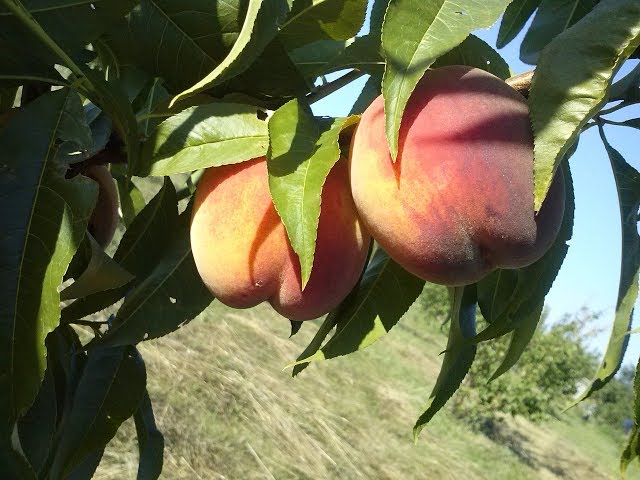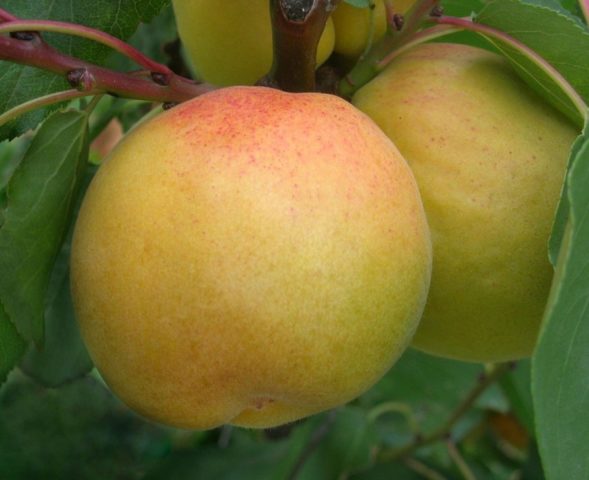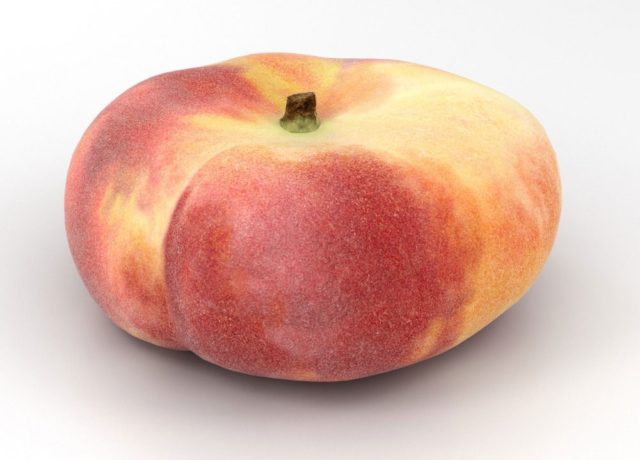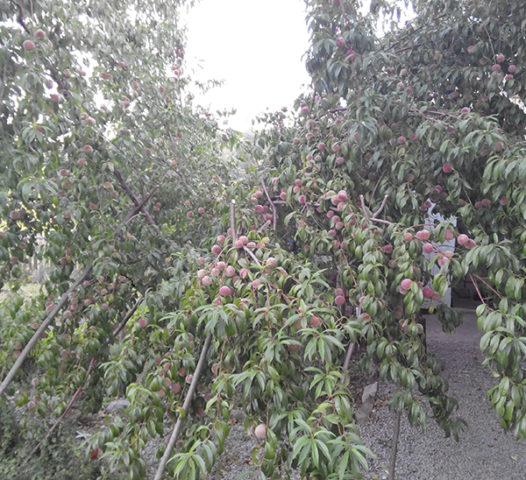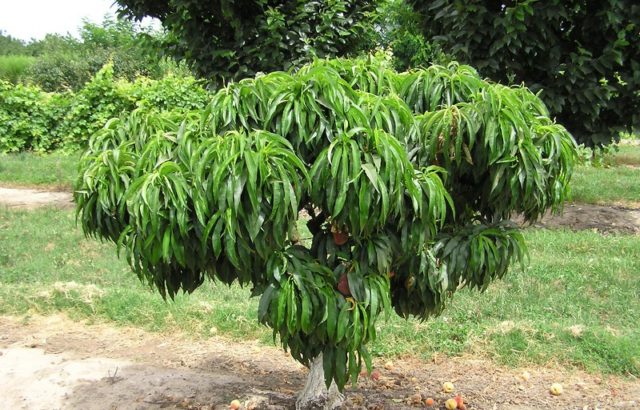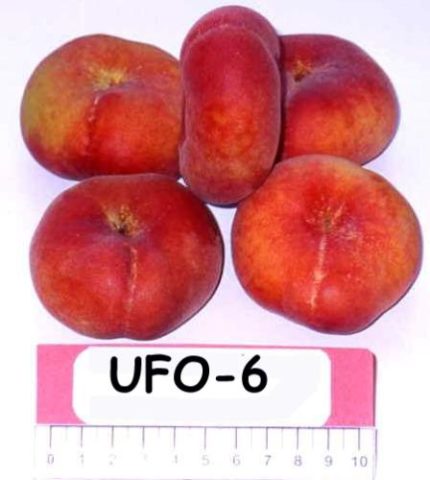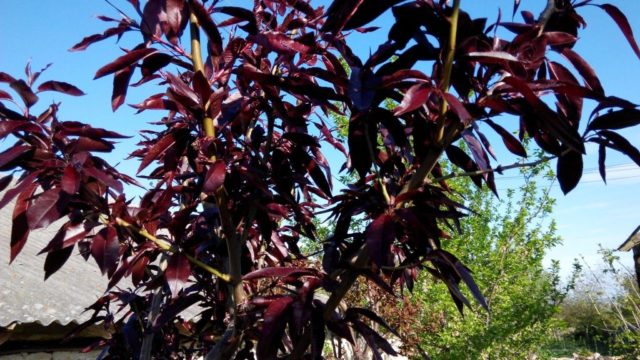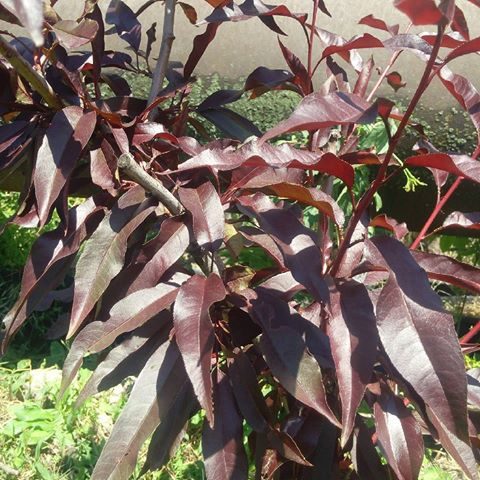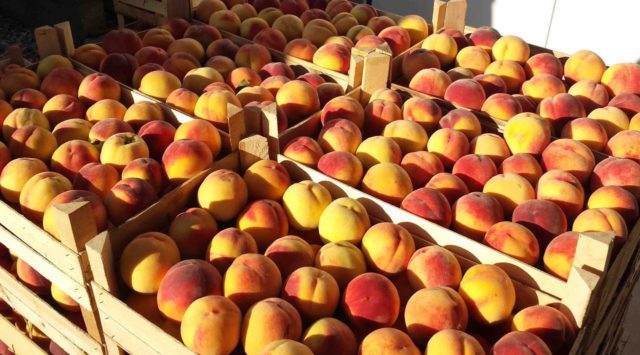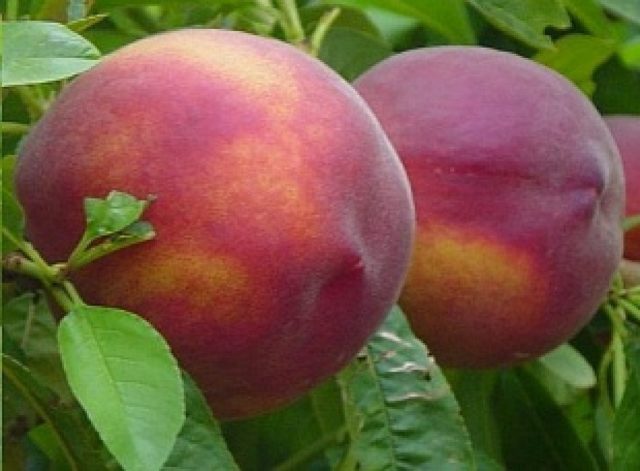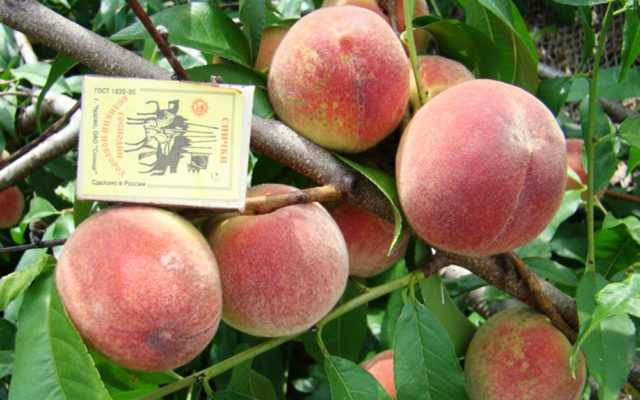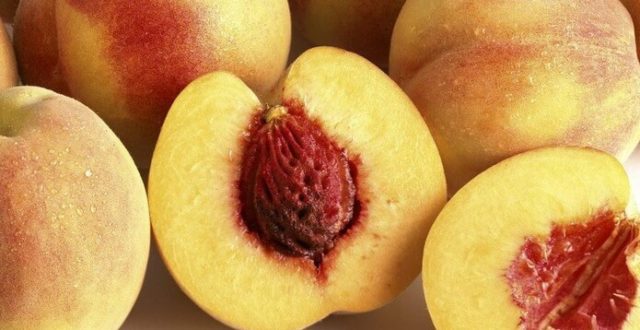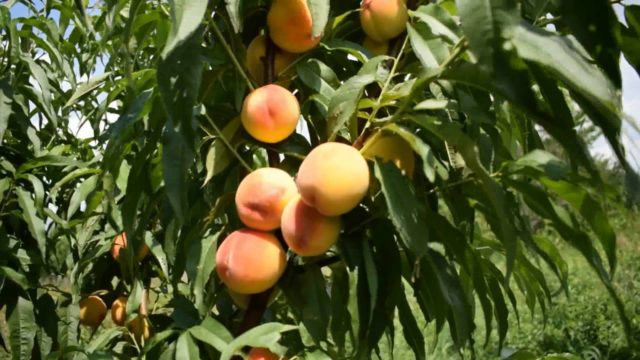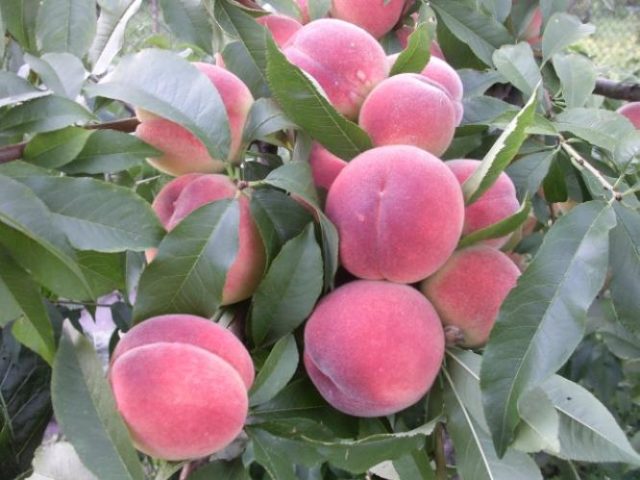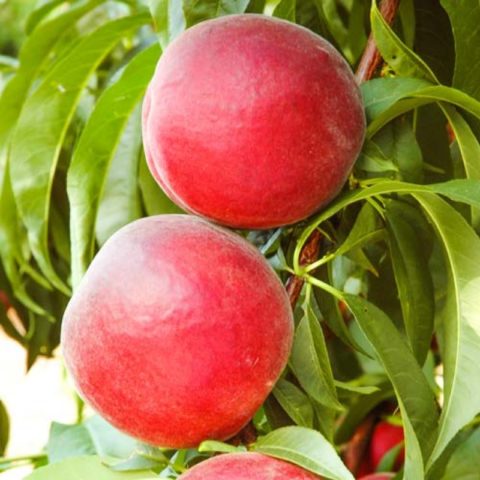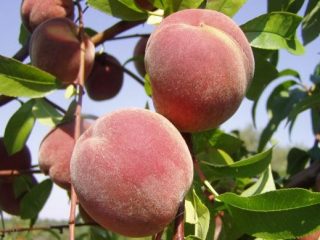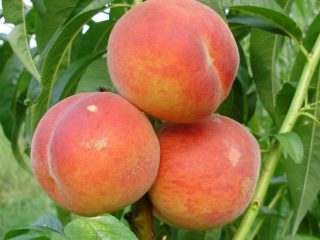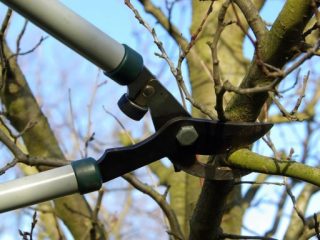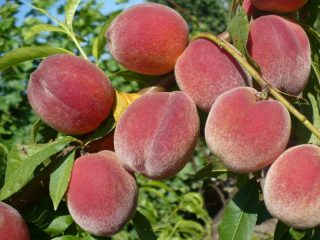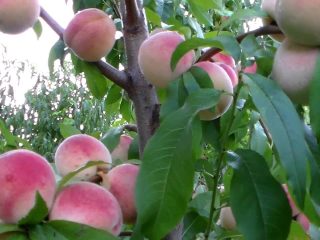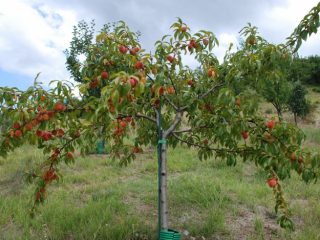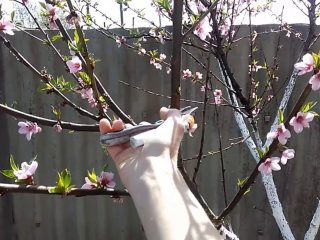Content
There is a wide variety of peach varieties. Recently, the range has been increasing due to the use of different types of rootstocks. Frost-resistant trees have been bred that grow and bear fruit in the Moscow region.
Variety of peach varieties
Owners of personal plots are amazed by the sea of peach varieties, which differ in shape, smell, color or ripening time, height and structure of the crown, and growing conditions. Pomologists distinguish peach trees by the appearance of their fruits and divide them into 4 categories:
- True peaches include plants that have pubescence on the fruit and the pit can be easily removed. A separate group is distinguished pavia – the stone does not separate, but the skin is pubescent.
- Fruits with smooth skin and easily separated seeds - nectarines. Those whose bone cannot be removed - brugnons.
- wild peach Potanin, characterized by a low crown, up to 2 m.
- Fig or Fergana peach with flattened fruits. The name is given because of its similarity to fig fruits.
New trees appear in each group every year. Modern selection is aimed at breeding frost-resistant or drought-resistant, columnar and dwarf trees. The culture differs in terms of ripening. Decorative specimens with burgundy or reddish leaves are popular.
When do peaches ripen?
Peach trees bloom and bear fruit over extended periods. The early ones enter the flowering phase in April-May, but due to their properties they can withstand spring return frosts down to -7.5 °C. Such varieties are planted in the middle climate zone, as well as in the Urals and Siberia. The fruits have time to ripen during the short warm season until mid-July and the first ten days of August.
Many representatives of the group of mid-season plants are frost-resistant. The ripening period for peaches is from August 10-12 to the end of the month. They are often grown in different regions of Russia, placed in cozy areas protected from the wind.
Late varieties are intended only for the North Caucasus region or the south of Crimea. They ripen from early September to October. In colder climates, the fruits of Southern peach varieties do not develop sweetness until frost.
Classification of peach varieties by ripening time
According to the time of fruit ripeness, peach trees are divided into early, mid-ripening, and late.
Early peach varieties
Early ripening plants bear fruit from 2-3 years. In most regions of Russia, it is necessary to plant zoned peaches.There are many European varieties that ripen in early summer, in June, but they may not take root in a continental climate, but only in the southern regions. Popular are frost-resistant representatives, fast-growing and resistant to pathogens of characteristic diseases. Gardeners will be able to navigate the varieties of peaches with photos and descriptions.
Variety Fluffy early can withstand frosts down to -28 °C, is little susceptible to diseases, and is zoned for the North Caucasus. The skin is creamy-greenish with a blush, the flesh is whitish, sweet and aromatic, satisfying in taste. The oval-round fruits weigh up to 100 g and ripen in July.
The name itself - Dagestan gold - indicates the preferred growing area. The bright yellow fruits with blush weigh 130 g, ripen from July 15-20, and are transportable. After frost damage, the tree recovers within 2-3 years and is resistant to curling.
Breeders from a neighboring country bred the peach Kazakh early, it produces fruits from June 25: spherical, pink-burgundy, weighing 80-120 g, with a harmonious taste. The plant is unpretentious, tolerates frost, and is little susceptible to diseases.
Fruits Kyiv early feast from July 3-6 in the south, from July 15 in the middle zone. Cream peaches weighing from 60 to 100 g are very aromatic, with sweet, light flesh. Plants tolerate frosts down to -20 °C and are affected by powdery mildew. The trees grow quickly and recover well after pruning.
Round fruits White Swan weigh 150-200 g, for dessert purposes, ripen from mid-August. The skin is a soft yellow shade, ruddy on one side. The sweet flesh is light cream. Drought-resistant and winter-hardy peaches. Flowers tolerate light frosts.
Varieties of medium-ripening peaches
Fruits of mid-season varieties are ready for harvest from August 10-15 to September. Trees bear fruit from 3-4 years of growth.
Peach Cardinal grows low, with a compact crown. Belongs to the varieties of large varieties of peaches: the fruits are large, 200-240 g, with yellow-red skin, bright pulp. The taste is tender, slightly fibrous. Tasters gave them a score of 5 points. The tree produces up to 44 kg of harvest, tolerates frosts down to -27 °C, but does not withstand frosts well and is little damaged by diseases. The variety ripens from August 10-14.
Peaches Stavropol pink varieties weighing 110-140 g, ripen from August 15-20. Round in shape, light yellow with a red half. Juicy white pulp, delicate in taste. The plant is low, the crown is dense. Resists curl, powdery mildew, and klyasterosporiosis. It was bred for the south of Russia; these peaches ripen well in Crimea.
Variety Vavilovsky adapted for cultivation not only in the southern regions, but also in the central ones. Very winter-hardy, mid-early, ripens by the end of July. The dessert direction was rated 4.8 points. Weight on average 250-300 g, pleasant yellow outside and inside, juicy and sweet. The medium-sized tree is relatively resistant to fungal infections.
Fruit variety Ambassador of Peace more than a third are carmine colored. They weigh 120-160 g, round, juicy and tasty. The pulp is tender and sweet, yellow, with a pleasant fibrous texture. They ripen by mid-August. The trees are resistant to diseases and frosts and can withstand droughts. Flower buds tolerate spring frosts.
Juicy fruit widely known for its bright fruits, weighing 150-200 g, three-quarters colored in a muted carmine shade. It ripens by the end of July and is very tasty. The fruits are elastic, with oozing juice. The stone is large and slightly detachable. The plants are tall, productive, and produce 60-70 kg. Flower buds tolerate frost.
Late peaches
They bear fruit from the fifth year of growth and are intended for the southern regions, no higher than the Rostov region, since all varieties become full of sweetness only by mid-September or early October. Late varieties of peaches are developing well in Crimea.
Variety Jaminat ripens during the first half of September. Oval, large fruits weighing 140-160 g are sweet, with a pleasant sour taste. The cover is deep red, with a soft yellow tint inside. Ripening is fast, the plant is resistant to infections, recommended for industrial cultivation.
Irganaysky late, like Jaminat, is the result of the work of Dagestan breeders, resistant to fungi. The same medium-sized tree produces fruit weighing 150 g at the same time from the beginning of September. They are colored a warm yellow with a wide blush. The yellow pulp is sweet, with a slight pleasant sourness. The bone comes off easily.
Peach Frost American selection, large-fruited - up to 200 g, and productive. It can be recommended to the group of peach varieties for the Black Earth Region, since, according to reviews, it can withstand frosts from 26 to 32 ° C and ripens in September. Universal in use, but American gardeners recommend using it for jams due to its fibrous texture.
An old variety Elberta also native to the USA, resistant, vigorous and large-fruited - up to 150 g. The skin is ruddy with a yellow background. The shape is oval, with an elongated sharp nose.The sweet pulp refreshes with a pleasant sourness. Ripens quite early for late-ripening species - from August 25-28.
Popular peach varieties
Well-known and hardy species are usually distributed among gardeners. Photos of peach varieties with names and descriptions will help you navigate the diversity of plants.
Frost-resistant peach varieties
Trees that recover well after a frosty winter were bred in Russia, Belarus, Ukraine, and the USA.
Mid-early peach Novoselkovsky tolerates frosts up to 28 ° C; in case of lower temperatures, the flower buds die, but the wood is restored over time. Little susceptible to fungal pathogens. Ripening occurs at the end of July. The fruits are 50-60 g, with a whitish-cream cover and the same pulp.
Crimean selection peach Golden Moscow with late flowering, it can withstand frost up to 18 °C, the wood can regenerate. Unpretentious, drought-resistant, resists powdery mildew. Belongs to the large-fruited category - 140-180 g. Ripening by mid-August.
The wood of this variety can withstand frosts of 20 degrees Siberian. A mid-season, productive plant quickly increases the mass of shoots and bears fruit from the third year. The fruits ripen during August: small, 25-40 g, quite tasty, juicy, sweet and sour.
Winter-hardy Saturn US selections are not afraid of frosts down to -27 °C. A vigorous-growing peach from the group of fig cultivars, productive, will ripen by the end of summer. Care includes bending powerful branches to the ground. The flat-round fruits are red-yellow on top, with a creamy tint inside. Juicy, sweet, the bone is difficult to separate.
Bush varieties of peaches
In areas of the middle zone, it is recommended to form any peach plant into a bush.Leave 8-11 shoots, periodically replacing them with new ones. Bush peach is easier to cover in frosty winters.
Resistant variety Voronezh bush plant was bred by amateur breeders and is suitable for regions with cool, short summers. The bush is compact, 1.5-2 m high. The branches bend to the ground; in severe winters they are pinned and covered, although the tree is not afraid of frosts down to -35 °C. Ripens in August, from the 2nd year of growth, the fruits are 90-120 g - juicy and tasty.
Peach Bush, winter-hardy and hardy, grown in Belarus and northern Ukraine. Resistant to fungal pathogens. It ripens from August 20, weighing 80-110 g. The fruits are oblong, creamy-yellow, with a blush, pleasant to the taste.
Dwarf varieties of peaches
Low-growing peaches, up to 2-2.5 m, are bred on the basis of the fig group. Species grafted on modern dwarf rootstocks, which are labeled with the term Nano, grow up to 1.5-2 m.
Balconella – mid-season variety, both dwarf and columnar. Although there are specimens with a spherical crown. Grows up to 1.2-1.5 m. Ripens in August, peaches weigh 90-145 g, 5-6 cm in diameter, tasty, juicy.
Variety Bonanza, up to 1.5 m tall after 10 years of growth, is grown in Europe and America to decorate patios. Planted in 10-30 liter tubs, providing sun, watering and fertilizer. The variety produces up to 4.5 kg of fruits, weighing up to 100 g, sweet and juicy.
Columnar peach Steinberg 1.8-2 m high, productive and mid-season. Resistant to fungal diseases. Produces large oval fruits from the next year after planting for 15 years: weight 140-205 g, with yellow juicy and tasty pulp.
Sweet Cap – winter-hardy variety, can withstand temperatures down to -23 °C, rises to 2-3.5 m. Harvest is good, fruits weigh up to 140 g, sour-sweet, with a refreshing, pleasant aftertaste. The skin is red-burgundy, the flesh is whitish.
Varieties of Italian selection called Ufo contains a whole series numbered from 1 to 12. The most popular are Ufo 2, 3, 4 and 5. Typical low-growing height of the fig group. Peaches are burgundy or red with a slight yellow background on the outside and white-cream inside, sweet. Weight 100-110 g.
Red-leaved varieties of peaches
Trees with burgundy-red leaves for decorative purposes are grown on cherry plum material Pissarda, which is characterized by this shade.
Peach Negus bears fruit and decorates the yard with red-violet leaves. Grows up to 3-4 m, on short rootstocks - 2 m. Frost-resistant, not affected by scab. Ripe by the end of July, the fruits are without pubescence, burgundy, sweet and sour.
Variety Burgundy ripens from August 10-15, weight up to 150 g, pink skin color. Planted for its decorative burgundy leaves, which by autumn acquire a light green tint with red veins. The tree is winter-hardy, up to -25 °C, 3-4 m high, rounded crown.
Red leaf nectarines Medvedevsky 1 and 2 – frost-resistant and hardy varieties of Ukrainian selection. Up to 3-4 m in height, with a slightly spreading crown, winter-hardy, mid-season, ripens from the beginning of August. Fruit weight 140-180 g, red-yellow skin and yellow flesh: juicy and sweet. The bone is separated.
American peach varieties
Typically, trees are distinguished by large fruits with high commercial qualities.
Mid-early, long-bred (1940) peach Redhaven – the most famous, still of industrial importance. The tree is vigorous, 5 m tall, drought-resistant, frost-resistant down to -25 °C, blooms late. Resistant to clasterosporiosis and powdery mildew, susceptible to curl. The fruits are tasty, 170-250 g. Productivity from 11 years old - 100 kg.
One of the best late varieties - frost-resistant Fleming Fury. Wood tolerates temperatures down to -28 °C. Ripens from mid-September: large-fruited peaches of orange color, covered with a pomegranate blush, weigh 200-300 g, and are stored for a week. We got 5 points for taste.
Early ripening Greensboro collected from the beginning of August. Oval fruits up to 120 g are covered with greenish-red skin, heavily pubescent. The inside is also greenish-creamy, juicy, sweet and sour, aromatic. There is resistance to frost and klyasterosporiosis.
Mid-season Golden Jubilee bred almost 100 years ago, but popular among gardeners in the south of our country. A variety with average frost resistance, vigorous, rises to 4-5 m, large-fruited - 125-170 g. The golden ruddy skin has slight pubescence, the flesh is tender and tasty.
New peach varieties
The goal of modern breeders is high consumer qualities of fruits and winter hardiness of wood. Self-fertile Canadian varieties are popular today.
Early vigorous Harbinger sings from the beginning of July. Weight 80-90 g, skin is ruddy, but of muted tones. Peaches are juicy, sweet, aromatic, transportable. The wood is frost-resistant; flower buds may suffer from frost.
Fast growing Harrow Diamond winter-hardy (- 28 °C).Round-oval fruits weigh 90-200 g, also of low saturated color, with orange, sweet and sour pulp. Suitable for transportation. They ripen in July and need to be regulated.
Winter-hardy early Harnas produces attractive, bright-red fruits that ripen from the beginning of August. The variety is distinguished by the fact that round peaches weighing 100-155 g do not fall off. The taste is excellent, the bone comes off easily.
American industrial grade Royal Majestic It is distinguished by winter hardiness, large fruit (over 200 g) and early ripening from mid-July. The spherical fruits are completely covered with a thick blush. Tasty, easy to use and transportable. The tree is not susceptible to diseases.
The best varieties of peaches for different regions of Russia
Peaches are a southern crop, and all varieties develop well and bear fruit in the south of Russia. Late species are planted here and will ripen before October.
Peach varieties for the middle zone
For weather conditions in the middle zone, the following varieties are chosen:
- early, those who manage to harvest during the warm season;
- winter-hardy and quickly restores wood;
- late flowering, when the threat of frost passes.
Varieties have these qualities Kremlevsky, Golden Moscow, Voronezh cluster, Veteran, Novoselkovsky, Jelgava, Forest-steppe early, Morettini's favorite, Madeleine Pouyer, Frost, Fury, Kyiv early, Juicy, Winter-hardy, Donskoy, Greensboro, Redhaven, Collins and others. Trees are planted in a north-protected and sunny location. In the first 2-3 winters, the seedlings must be covered by erecting a kind of tent over and around the tree.
Peaches: varieties for southern Russia
In southern gardens, any type of crop is grown, except tropical ones. Popular are those that bear fruit late and are highly marketable: Autumn Blush, Irganaysky late, Jaminat, and Dagestan gold, Fluffy early, Solar, Soviet, Steppe news, Sunrise, all nectarines and others.
Peach varieties for Kuban
The current varieties of peaches for the Krasnodar region are those that can withstand frost and are not affected by diseases. Resistant to frizz Erlired, Stark Red Gold, Springtime, Sunhaven, Redhaven, Madeleine Pouyer, Early Kuban. The best varieties are zoned: Autumn Blush, The Velvet season, Early Kuban, Memory of Simirenko, Morettini's favorite, Springold, Collins, as well as fig peaches.
Crimean varieties of peaches
Judging by the description and photo of the varieties of peaches in Crimea, the same disease-resistant and frost-resistant species are popular here. The trees grow well in areas with sandy loam soils, protected from northern winds. The Crimean peaches include the zoned varieties selected by the Nikitsky Botanical Garden: Kremlevsky, Golden Moscow, Juicy, Fluffy early, Red-cheeked, Red Maiden, Tourist. Among the others: Fairy tale, Soviet, Dandy, Morettini's favorite, Redhaven, Veteran, Greensboro, Cardinal, Golden Jubilee. Nectarines are grown Lola, Evpatoriya, Kyiv.
The best varieties of peaches for the Moscow region
Zoned trees, formed in the form of a bush, take root well in this region. Those varieties are planted that can withstand frosts down to -25 °C, with late flowering periods, and quickly regenerating wood. Early and mid-ripening fruits ripen here: Donskoy frost-resistant, White Swan, Greensboro, Morettini's favorite, Kyiv early, Redhaven; Columnar frost-resistant – early Honey, mid-season Steinberg; disease-resistant nectarines Redgold, Big Top, Crimson Gold.
Self-fertile varieties of peaches - myth or reality
Productivity increases if cross-pollination occurs between trees planted in a group. Self-pollinating varieties produce a large yield of fruits even when they grow alone. For the Moscow region, self-fertile varieties of peaches are more profitable, since it is easier to work in such a climate with one plant. Popular:
- frost-resistant variety Golden Moscow;
- Crimean mid-season variety Fairy tale;
- disease resistant Golden Jubilee – for the south;
- productive early Harnas;
- mid-season frost-resistant Volcano with dense fruits (Canadian series Tward Tardiv);
- mid-season winter-hardy Inka.
Conclusion
Peache varieties are selected by region, guided by their qualities and ripening time. There are unpretentious trees that give a good harvest. Simple care and compliance with agricultural technology requirements will ensure successful development of plants.
